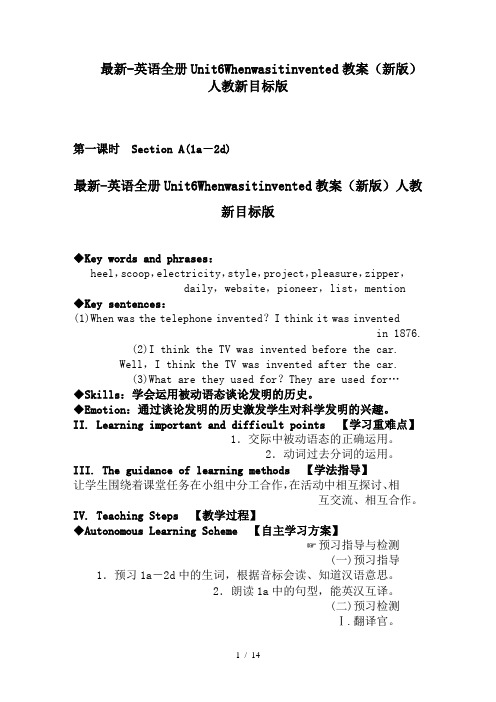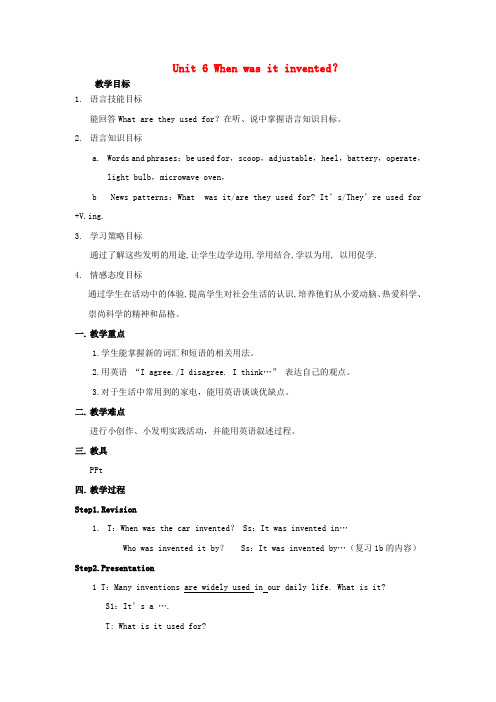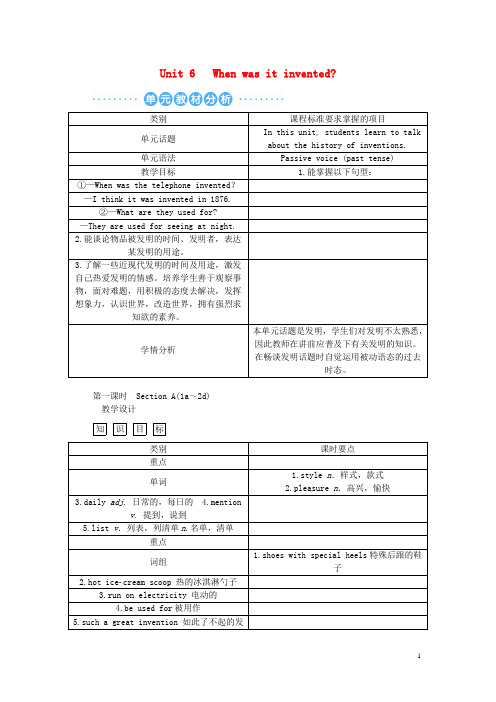Unit 6 When was it invented?(第2课时)教案 (新版)人教新目标版
- 格式:doc
- 大小:40.50 KB
- 文档页数:3

最新-英语全册Unit6Whenwasitinvented教案(新版)人教新目标版第一课时Section A(1a-2d)最新-英语全册Unit6Whenwasitinvented教案(新版)人教新目标版◆Key words and phrases:heel,scoop,electricity,style,project,pleasure,zipper,daily,website,pioneer,list,mention◆Key sentences:(1)When was the telephone invented?I think it was inventedin 1876.(2)I think the TV was invented before the car.Well,I think the TV was invented after the car.(3)What are they used for?They are used for…◆Skills:学会运用被动语态谈论发明的历史。
◆Emotion:通过谈论发明的历史激发学生对科学发明的兴趣。
II. Learning important and difficult points 【学习重难点】1.交际中被动语态的正确运用。
2.动词过去分词的运用。
III. The guidance of learning methods 【学法指导】让学生围绕着课堂任务在小组中分工合作,在活动中相互探讨、相互交流、相互合作。
IV. Teaching Steps 【教学过程】◆Autonomous Learning Scheme 【自主学习方案】☞预习指导与检测(一)预习指导1.预习1a-2d中的生词,根据音标会读、知道汉语意思。
2.朗读1a中的句型,能英汉互译。
(二)预习检测Ⅰ.翻译官。
1.shoes with special heels________________2.hot icecream scoop________________3.the style of the shoes________________ 4.the subject for my school project________________5.my pleasure________________6.have a point________________7.runs on electricity________________8.shoes with lights________________ (Keys:1.带有特殊足跟的鞋;2.热冰激凌勺;3鞋的风格;4.我的学校项目课题;5.愿意为您效劳;6.有道理;7.电力驱动;8.带灯的鞋)Ⅱ.完成书中第41页1a的练习。

When was it invented 单元主题Unit 6 When was it invented?教材分析本单元主要围绕“发明”而展开一系列学习活动,介绍了我们日常生活中一些常见物品的发明历史,同时呈现了本单元的语言结构被动语态的过去时。
Section B 依然围绕发明创造这个话题,使得学生继续学习和巩固相关的内容和语言知识。
在整个学习过程中学生对本单元语言目标加以巩固,综合能力得以提升。
单元教学目标一、知识与技能1. 词汇:style,project,pleasure,website,pioneer,list,ruler,smell.trade.doubt,customer,instrument,boil,mention, remain,etc.2. 能正确使用被动语态的过去时。
3. 能力目标:能简要讨论发明的历史。
二、过程与方法灵活运用教材,从所教学生的实际水平和语言能力出发,调整和取舍教学内容,合理安排本单元的课时数,设计好每课时的教学内容。
三、情感、态度与价值观1.通过课堂的合作互动,增进同学间的了解,增进感情。
2.培养学生们对英语的兴趣。
3.了解一些近现代发明的时间及用途,激发自己热爱发明的情感。
培养想象力,善于观察事物。
面对难题,用积极的态度去解决,发挥想象力,认识世界,改造世界。
重难点:一般过去时的被动语态课时安排Period 1:S ection A:1a-1cPeriod 2:Section A:2a-2dPeriod 3:Section A:3a-3cPeriod 5:Grammar Focus: 4a-4c Period 6:Section B:1a-1ePeriod 7:Section B:2a-2ePeriod 7:Section B:3a-Self check。

Unit 6 When was it invented?教学目标1.语言技能目标能回答What are they used for?在听、说中掌握语言知识目标。
2.语言知识目标a.Words and phrases:be used for,scoop,adjustable,heel,battery,operate,light bulb,microwave oven,b News patterns:What was it/are they used for? It’s/They’re used for +V.ing.3.学习策略目标通过了解这些发明的用途,让学生边学边用,学用结合,学以为用, 以用促学.4.情感态度目标通过学生在活动中的体验,提高学生对社会生活的认识,培养他们从小爱动脑、热爱科学、崇尚科学的精神和品格。
一. 教学重点1.学生能掌握新的词汇和短语的相关用法。
2.用英语“I agree./I disagree. I think…”表达自己的观点。
3.对于生活中常用到的家电,能用英语谈谈优缺点。
二. 教学难点进行小创作、小发明实践活动,并能用英语叙述过程。
三. 教具PPt四. 教学过程Step1.Revision1.T:When was the car invented? Ss:It was invented in…Who was invented it by? Ss:It was invented by…(复习1b的内容)Step2.Presentation1 T:Many inventions are widely used in our daily life. What is it?S1:It’s a ….T: What is it used for?S2:It’s used for….(Teach: microwave oven, light bulb )( Practice:be used for +V.ing). T:A: What are light bulbs used for? B: They are used for seeing in the dark.2.Work in pairs: ---What’s it/ are they? It’s a/an…They’re…---What is it /are they used for? It’s/They’re used for….3.Practice: be used for +V.ing (连线)Step3.Listening1.T:Inventions are everywhere.Have you ever seen these inventions?2.T:Listen and number the inventions in the order that you hear.(2a)3.T:Listen again. Match the inventions with their inventors and uses.(2b)Step4.Practice1.Make a dialogue(pairwork)according to the listening materal.2.T:New inventions are invented all the time. Most of the inventions arehelpful, but some of them are annoying. Please make a list.(3a)3.Pairwork(3b)Discuss your opinions in 3a with your partner.A: What do you think is the most helpful invention?B: I think the most helpful invention is the light bulbA: Why is that?B: Well, it gives people more time to work and play every day.A: What do you think is the most annoying invention?B: I think the most annoying invention is junk foodA: Why is that?B: Well,eating too much of it is bad for our health4.GroupworkImagine that you are alone on a tiny(小的) island. If you can only take five inventions, what would you take? Why?Eg:If I am alone on a tiny island, First, I’d like to have …because…. Then….Next….Then… Finally….Step3. Homework1.Listen2a、2b2. Make sentences:be used for3. WB4.Writing六.Bb designUnit9 When was it invented? Section A(2a-4) 七反思。

Unit 6 When was it invented?(第2课时)【学习目标】1.知识和技能目标:After learning the text, require the students to master the phrases below: (通过学习,掌握下列词语) invent, popular drink, by accident, not…until, discover, according to, Chinese legend, boil, an open fire, fall (fe ll) into, remain(ed), notice(d), produce(d), in this way2.过程与方法目标:1.Practice the students’ listening ability. (听力训练) 2. Ask the students to understand the passage very well and answer some questions according to the passage. (能够正确理解本文含义,回答相关问题。
)3. Useful phrases for the students to retell the new text. (利用关键词语,能够复述课文大意。
)3.情感、态度和价值观目标Train the students to use their heads and make some inventions in life.(开动脑筋,培养发明创造能力.)【自主梳理】1. 要求学生翻开课本P43,迅速阅读3a部分的内容。
并按要求完成课本上相应的任务:2. 检查答案,先要求全班一起给出答案并检查讨论。
work in groups and solve problems together【重点领悟】教学When was the tea invented? It was invented in … .【探究提升】I质疑探究:质疑解疑、合作探究教学建议:探究点中pleasant是学生学习难点,请老师要给予适当点播学习建议:分析所给例句,根据提示总结重难点单词、语法、及句型用法探究点一语篇探究教学建议:教师给学生留出3----5分钟时间,读3a,再根据文章内容,排序。


Unit 6When was it invented?类别课程标准要求掌握的项目单元话题 In this unit, students learn to talk about the history of inventions.单元语法Passive voice (past tense)教学目标 1.能掌握以下句型:①—When was the telephone invented?—I think it was invented in 1876.②—What are they used for?—They are used for seeing at night.2.能谈论物品被发明的时间、发明者,表达某发明的用途。
3.了解一些近现代发明的时间及用途,激发自己热爱发明的情感。
培养学生善于观察事物,面对难题,用积极的态度去解决,发挥想象力,认识世界,改造世界,拥有强烈求知欲的素养。
学情分析本单元话题是发明,学生们对发明不太熟悉,因此教师在讲前应普及下有关发明的知识。
在畅谈发明话题时自觉运用被动语态的过去时态。
第一课时Section A(1a~2d)教学设计知识目标类别课时要点重点单词1.style n.样式,款式2.pleasure n.高兴,愉快3.daily adj. 日常的,每日的4.mentionv. 提到,说到5.list v.列表,列清单n.名单,清单重点词组1.shoes with special heels特殊后跟的鞋子2.hot icecream scoop 热的冰淇淋勺子3.run on electricity 电动的4.be used for被用作5.such a great invention 如此了不起的发课堂环节§自主学习案翻译下列词组。
1.特殊后跟的鞋子shoes__with__special__heels2.热的冰淇淋勺子hot__icecream__scoop3.电动的run__on__electricity4.被用作be__used__as5.学校项目的课题the__subject__for__my__school__project6.我们的日常生活our__daily__lives7.有点道理have__a__point§课堂导学案Step 1 准备与热身(Preparation)展示一些近代发明的图片与近代发明的发明者,让学生们将图片与发明者相连。
教学准备1. 教学目标掌握一般过去时的被动语态的特殊疑问句2. 教学重点/难点一般过去时的被动语态的特殊疑问句结构是“疑问词+be动词+主语+动词的过去分词+其他?”3. 教学用具4. 标签教学过程Step 1 Warming upT: Can you tell me some great inventions that are important in our daily life?Ss: Yes. The mobile phone, the computer, the airconditioner, the fridge, the light and so on.T: Yes. The inventions have changed our life.Step 2 Presentation (1a)Look at the four things in 1a. In what order do you think they were invented? Get the students to discuss them with their group. Then number them [1-4].Step 3 Listening (1b)(有一定难度,增设听力训练题见素材三)1. Listen for the general idea of 1b.The general idea of the conversation is about _______.A. who invented the thingsB. when the things were inventedC. where the things were invented[答案] B2. Listen for the specific ideas of 1b.Get the students to listen and match the inventions with the years.[答案] d;a;c;b3. Check their work with the whole class.Step 4 Pairwork (1c)Student B, cover the dates. Student A, ask Student B when the things in the picture in 1b were invented. Then change roles and practice again.e.g.A: When was the…invented?B: I think it was invented in…Step 5 PresentationT: Look at the picture in 2a. There are some inventions on the table. What are they?Ss: They are shoes with special heels, shoes with lights and hot ice-cream scoop.T: They are small inventions and they can make our life more interesting and convenient. Two students are talking about them.Step 6 Listening (2a-2b)1. Get the students to listen and number the inventions [1-3] in the order they hear them in 2a.2. Have the students listen again and complete the chart in 2b.[答案] 1.3; 1; 2 2.changing; in the dark; servingStep 7 Practice (2c)Ask the students to make conversations in pairs using the information in 2b.e. g.A: What are they used for?B: They are used for…Step 8 Roleplay (2d)1. Read for the main idea of 2d.(略读,了解大意)The main idea of 2d is about _______.A. some small inventionsB. a small invention—the zipperC. a school project[答案] B2. Read for the specific ideas of 2d.(细读,把握关键信息点)Read the conversation again and find out the answers to the following questions.(1)Who invented the zipper?(2)When was the zipper invented?(3)When was it used widely?[答案] (1)Whitcomb Judson. (2)In 1893. (3)Around 1917.3. Read after the tape.4. Read the conversation aloud in pairs.5. Roleplay the conversation in pairs. Then go to the front of the classroom and perform it to the whole class.Step 9 Language points(详见P212 课堂互动探究)be used for, be invented by…课堂小结1. 一般过去时的被动语态表示主语是过去某个动作的承受者,谓语动词由“was/were+动词的过去分词”构成。
unit6whenwasitinvented教案1. 引言好的教案对于教学的重要性不言而喻。
其中涵盖的教学内容、教学方式、教学目标等都是影响教学效果的重要因素。
针对单元“when was it invented”,我们需要一份高质量的教案来辅助我们的授课。
本文就是一份针对这个单元的教案,内容涵盖课程目标、教学内容、教学方式、教学评价等。
2. 课程目标本课程的主要目标是要掌握讲述物品发明和发展历程的相关英语知识,以及学会用英语谈论一些物品的历史和发展。
通过课程学习,学生将会:- 了解一些物品的发明及其发展历程;- 学习如何用英语描述物品的发展历程;- 培养学生的口语交流能力;- 提高学生的英语阅读和写作能力。
3. 教学内容(1) 课文教学:通过课文学习,了解一些有影响力的物品发明历程。
(2) 词汇学习:学习本单元出现的一些常用词汇,如invention (发明)、device(装置)、telephone(电话)等。
(3) 语法学习:了解过去分词的用法和应用场景。
(4) 口语表达:通过各种练习,提高学生口语表达和交际能力。
(5) 写作训练:通过写作训练,提高学生英语写作能力。
4. 教学方式本课程主要采用任务型教学方式,通过完成一系列的任务来巩固学习内容,确保学生能够真正掌握所学知识。
同时,也会注重听说能力的训练,加强学生的口语表达能力。
具体的教学方式包括以下几个环节:(1) 师生互动环节:老师可以通过提问学生的方式来了解学生已有的知识水平,并及时调整课程内容。
(2) 录音听力环节:利用录音机等设备来听课文录音以及一些听力练习。
(3) 词汇学习环节:教师让学生背诵一些单词、短语,并将其出现在对话中密集讲解。
(4) 任务型学习环节:选取一些任务性课程活动,包括对话、问答、小组活动等,通过已学知识完成任务,以此来巩固所学知识。
(5) 写作练习环节:让学生写一篇介绍物品发展历程的文章,以此来提高学生英语写作能力。
Unit 6 When was it invented?(第2课时)
一、教材分析:
本课选自初中英语新人教版九年级(2014)新改版。
谈论的话题是有关“发明”的话题。
要掌握的结构是被动语态。
本课时的教学内容是听力与口语相结合,重难点是词汇和短语教学。
二、三维目标:
1.知识和技能目标:
1)谈论重要发明的发明时间,发明者和用途。
2) 了解薯条、茶和篮球的发明历史。
2.过程与方法目标:
1)能运用所学知识练习被动语态的句式。
2)能用所学句型进行交际练习。
3.情感、态度和价值观目标:
充满想象力,善于观察事物,面对难题,用积极的态度解决,发挥创造能力,认识世界,改变世界。
三、教学重点:
单词,短语和句型。
四、教学难点:
运用被动语态谈论重要发明的时间、发明者和用途。
五、教学策略:
通过谈论重要发明的练习,充分掌握被动语态的用法.
六、教学准备:
多媒体课件教科书课前预习学案。
七、教学环节:
DISCOVERING LANGUAGE
(1).Look at the screen and complete the questions. Let the students do it by themselves on their books,and ask one to show his answers to the class. The answers are:
1)It was invented in 1876.
2)It is used for traveling.
3) It is used for seeing in the dark.
4)It is used for serving really cold ice cream.
(2). Complete the following questions;using the word cues;make necessary changes. Let students do it by themselves and the teacher move around the classroom,give them the necessary help. Check the answers:
1). invented
2). drinked
3). produced
4). brought
5). traded
DEVELOPING SKILLS
1. Listen and choose the best response to what you hear. First listen only, then do it the second time.
2. Listen to Miss Green’s lecture and decide whether the following statements are true or false. Make the answers by class themselves.
3. Work in pairs.
Interview the partners in your group, ask them some questions and write down, then report to the class.
Read the passage and choose the best answers
Tell the students to read the dialogues carefully,and think it over,then complete it. First ask the students talk about his or her answers with classmates. Check the answers :
4b. 1. were invented
2. were brought
3. was locked ; rang
4. were telled ; broke
5. were eaten ; liked
4c. was invented ; was born ; worked ;
learned ; was invented ; was said ;
was used
homework
1.Write a passage about a new invention and introduce it.
2.Do some relevant exercises .
(设计说明:运用并拓展本课时所学知识,让学生在写作中进一步巩固所学知识,并掌握本课时的新词和短语。
)
语法 :
(一) 语态分类
英语动词有两种语态.,主动语态和被动语态。
主动语态表示主语是动作的执行者,被动语态表示主语是动作的承受者。
如:
They will build a new bridge over the river. (主动)
A new bridge will be built over the river. (被动)
汉语中常用“被”、“给”、“由”、“受”等词用来表示被动,而英语用:
助动词be + 及物动词的过去分词构成。
(二) 被动语态的时态、人称和数的变化主要体现在be的变化上,其形式与系动词be的变化形式完全一样。
一般现在时:am / is / are + done
一般过去时:was / were + done
一般将来时:shall / will + be done
一般过去将来时:should / would + be done
现在进行时:am / is / are + being + done
过去进行时:was / were + being + done
现在完成时:have / has + been + done
过去完成时:had + been + done
将来完成时:shall / will + have been + done
过去将来完成时:should / would + have been + done
[注]被动语态没有将来进行时和过去将来进行时。
八、板书设计:
九、教学反思:
本课主要话题是谈论重要发明的发明时间、发明者及用途。
主要练习被动语态的句式用法。
难度较大,但是学生们对发明话题很感兴趣,所以学习积极性很高。
反思这堂课的教学,我认为优点有以下几点:
1、从学生熟悉的话题入手,引导学生理解课文;
本节课教师从学生熟悉的发明话题入手与学生进行讨论,学生接受,全员参与,很好的调动了学生的学习热情,为整节课做好了铺垫。
通过第一遍听录音回答简单问题,到第二遍听进一步回答问题,再到最后听并跟读,教学设计有层次性,由简到难,由浅到深,引导学生一步步进行学习。
2、利用点读笔做听读训练,方便高效,学生喜欢;
在学习单词和课文的环节,我利用点读笔的功能让学生听录音进行学习,由于点读笔发音清晰纯正,因此听得清,模仿得也好。
学生最后朗读的时候不仅有声有色,表情也自然而然带了出来。
由于模仿效果好,学生有了自信,特别是我利用点读笔下去到学生中间点读的时候,很多学生非常兴奋,声音洪亮整齐地到读课文。
课堂气氛非常热烈。
合理利用点读笔的功能,可以有效提高学生的学习效率,学习效果和学习热情。
小学生处于学习英语的初级阶段,对正确的语音语调和语流中典型发音特征规律的了解和掌握学习对其以后的听说学习影响非常大。
教师应注意在这些发音方面做处理。
帮助学生掌握这些发音规律。
3.与学生积极进行了交流。
尤其是小组学习过程和展示过程中,教师做到了很好的指导和精讲点拨,做到了三讲三不讲。
教师的评价及时到位,评价语比较丰富。
时间把握比较紧凑,均衡分配了单词和课文的学习时间和教学内容。